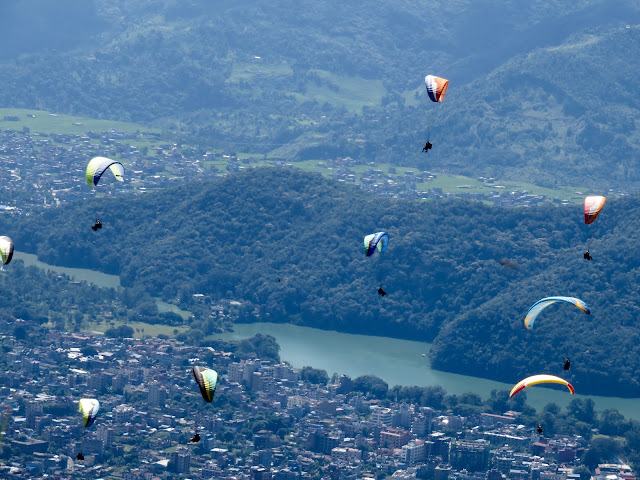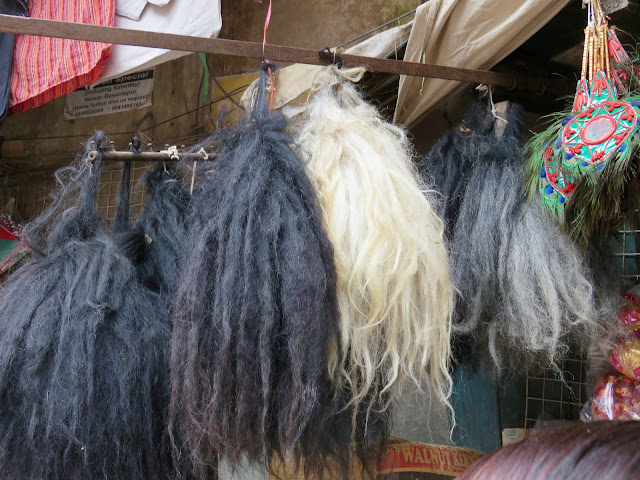9/30/16
Ahhh Pokhara, how you have grown. In 1988 it was a small town that mainly serviced trekkers that were here to set off into the mountains, specifically in and around the Annapurna range of the Himalaya. There were hotels and restaurants, but mainly the back packer type. I think my friend Ron Dunetz and I paid like, $3 a night. Nothing hinting at being upscale. It is not surprising that this has changed. Not only is Pokhara so well situated in terms of the BIG mountains, but it sits on the very lovely Lake Phewa. Lake Phewa is the second largest lake in Nepal, but even with that it is not huge. The river valley that feeds it is, but the lake itself retains a calm demeanor most of the time. One interesting factoid is that no motor boats are allowed on the lake. All transportation is by canoe shaped boats with a flat bottom, or even paddle boats for the tourist.
 |
| Boat with Peaking Pagoda Lake Phewa, Pokhara, Nepal |
There are many houses on surrounding hillsides that have no road access. The lake is their road (much like the village where Cynthia and I live in Guatemala) but they have no choice but to row or paddle wherever they may be bound. Rough if you have forgotten that dozen eggs!
Cynthia and I came here with no plan. It was good to relax and see what unfolded. Getting out on the lake seemed like a no brainer, and after doing a bit of reading it became apparent that we could accomplish two things in one journey. In the 90’s a Japanese Buddhist group completed a Peace Pagoda (stupa) high on the very top of the “hill” overlooking the lake and Pokhara.
 |
| Peace Pagoda Pokhara, Nepal |
One can get close to it by road; but a more interesting, and heart building, way is to go by boat, then climb to the pagoda. Cynthia and I did just that. At the trail head a sign says it’s a 45 minute climb up the trail. Two hours later Cynthia and I arrived. Not that it beat us up, but we took our time, had tea, looked at the flora and fauna, and just enjoyed ourselves. The view from the top was wonderful. Unfortunately we were too late to see the huge Annapurna range, off in the not too far distance, as the inevitable clouds had moved in to obscure it. Still, definitely worth the climb. No doubt it is the closest thing to a trek on our agenda for this trip!
In the afternoon we moved on to the very excellent International Mountain Museum. The facility is huge, and of course dedicated to the most majestic mountain range on the planet, the Himalayas. The museum had exhibits on everything from the different tribal people that inhabit them to the problem Mt Everest is having with garbage (sound familiar?) Actually the museum was so large that it was almost intimidating. I got a bit weighed down in the geology section, but perked up again when reading about the feats of some of the climbers.
When I was at the Annapurna Base Camp there was no where else to go but up with a technical climb. As I stood on one of the ridges and heard the winds howl and the avalanches growl, I realized I had no desire to be a mountain climber. “Because it is there” just didn’t do it for me. But seeing how these monsters were formed, how amazing they are in terms of size on a global sense, and how men and women can turn a suicide mission into a sport was pretty fascinating.
10/1/16
I love riding motorcycles. In India, in the out of the way places we were traveling, we saw so many groups and individuals have an ultimate adventure on those torturous roads. Yet the bug just didn’t hit me. Conditions too severe, weather too severe, the bikes not really right for the long haul gear wise. No such thing as a hard pack, everything was tied on with a plastic sheet trying to protect it from the elements. So finally in Pokhara it seemed that the time was right. Cynthia and I rented a 350 cc Royal Enfield, the rather classic bike of choice here. The idea was to ride to the Sarangkot overlook to experience the jaw dropping view of the large Annapurna range. The guides and agencies push doing this for sunrise. We were going to go early, but we planned on still being in bed at sunrise! The day before we had seen a clear sky and good mountain views from our room, then saw the clouds move in as the day became later. Somehow we thought this would be the pattern. Wrong. The first thing I did when we got up was to look out our window to see it totally clouded in. Rats! We decided to go for anyway, hoping the clouds would take a hint and move on.
I had partially scoped out the route the day before and thought I knew it. Wrong again! I missed the turn, and we ran into totally strange territory in the middle of Old Pokhara. As I was struggling along, trying to make a decision as to where to go, what do we run into but a parade!
 |
| Parade Old Pokhara, Nepal |
And a long one. Masks, music, a float and dancers passed us by. Now usually Cynthia and I would be totally up for this. But please, not now! The clouds were clearing and we wanted so much to reach our destination. Finally I asked a fellow motorcyclist how to get to Sarangkot. He said, “follow me”. What a guy! We were weaving and winding and guess what? We ran into the parade again! So we watched it for the second time.
 |
| Goddess for a day Old Pokhara, Nepal |
After several other miss starts we finally did make it to the overlook. The mountains were incredible though the clouds obscured them enough not to give us a clear view of the entire range. Kind of foiled, kind of successful.
One side note. Pokhara is literally famous for its paragliding. Lonely Planet states that it is one of the best spots on the planet to give it a go. Well the launching spot is from the side of the mountain in Sarangkot. Cynthia and I were astounded at how many gliders were taking off. At one point I would say we could count fifty of them in the sky.
 |
| Paragliders' Paradise Sarangkot, Nepal |
And that continued most of the day! For $85 you could get a 20 minute ride that you would never forget. For $115 you could stretch that to 45 minutes. The lake and entire valley would be in view. If you caught a thermal and the clouds were right one could see the mountain range as well. Cynthia had the urge to do it, but she needed some time to build up to it and we just didn’t have it. I certainly gave her credit for even considering it!
Since we had been semi-foiled on the morning’s excursion we had heard about a spot where two lakes lay side by side, and the report was that it was beautiful. We decided to give it a try. The ride on the main road was no fun, but miraculously Cynthia spotted our turn off about 30 minutes out of town. We were not disappointed. A very quiet road in great shape took us to an overlook of the lakes that was spectacular.
 |
| Lake Rupa, Nepal |
No honking horns, no traffic, no tourists (except us), no one trying to sell us anything. It was great and worth the effort to get there, and back again.
On the way we saw an interesting phenomenon. There was a herd of goats close to the road with lots of people stopped to check them out. At first I thought it was tourists fascinated by the scene. We decided to stop and take it in ourselves. Next thing we saw was a goat being muscled into the back of an SUV. Then we saw one being crammed into the trunk of a car. What’s up with this?
 |
| Goats for Sale Pokhara, Nepal |
Cynthia thought maybe it was a goat sale so they could introduce new stock to their herd. Stop the inner breeding. Well come to find out a big holiday is coming and having goat meat is the tradition. Apparently Pokhara is famous for their goat sales and people come from all over the region to sell and to purchase their goats for their holiday feast. No wonder the goats were putting up such a fight!!!
10/2/16
Well tonight we are tripping the light fantastic. This evening is our last night in Pokhara. So we indulged. Today I tripped out on the moto while Cynthia went to the spa for the full treatment. We both got what we wanted. I got a ride where there was no traffic, beautiful scenery, a local flavor, and a sense of fulfillment. Cynthia got a pedicure, a full body scrub and a facial. When all that was complete we went lakeside and indulged in a couple of beers accompanied by a peanut sadeko. As those who know me are aware, I have a jones for peanuts. (One of the few snacks that are relatively few on the evil carbs). Well here they make a peanut mix with a variety of spices and vegetables. Spicy and heavenly. We watched the people go by, saw the sun set over the lake, and fully appreciated how lucky we are.
When darkness set in and the thunder began we made our way to our favorite restaurant here in Pokhara. Moondance. This restaurant could be a hit in any hip community in the States. Service is beyond good, and the food imaginative and excellent. We accompanied our dinners with a pitcher of mojitos (dangerous) and finished it all off by splitting a piece of their “famous” lemon meringue pie. What the hell more could we want? Just for the record, after a tasty salad, entree for the both of us, the exquisite pitcher of ecstasy, and the heavily pie, a bit less than $50 including tip. For Nepal that is an indulgence, in the States it is getting to be a salad, a burger and maybe a beer. Again, the value is here.
Our adventure is nearing an end. Tomorrow we head back to Kathmandu to spend two nights. Oh, and no bus, this time we fly! All of 25 minutes as opposed to the seven hours on the bus. (You have to love a country that has national airlines with the names “Yeti Airlines” and “Buddha Air”).
 |
| Our Yeti Pokhara, Nepal |
Then the twilight zone begins as we fly from Kathmandu, to Delhi, to Newark, to Detroit. I think we gain back that illusive day somewhere in there.
10/5/16
We are now in the Delhi airport with our eleven hour layover. Yes, you heard that right, eleven hours! They won’t let us in the main departure lounge until 3 hours before the flight. So here we are in the waiting-for-the-departure-lounge lounge. Not exactly cush but we are making do. I like to relate some final reflections on the trip, but now is not the time. In a sentence, it couldn’t have been better. That is unless Kashmir had found a way to peace which, as I write, seems as far away as ever. Know that Cynthia and I are happy, healthy and so glad we had this “Great Adventure”.
 |
| Temple Monkey Kathmandu, Nepal |







































